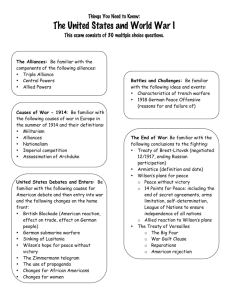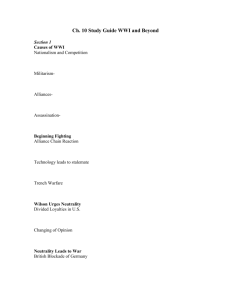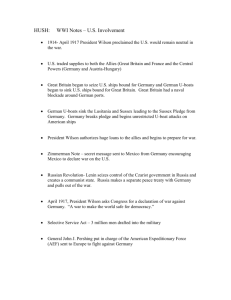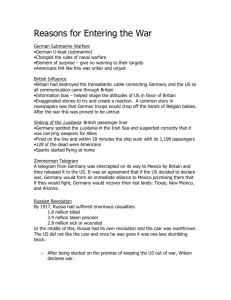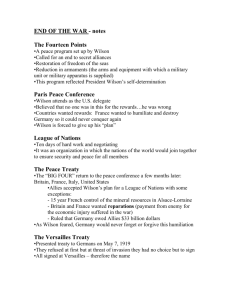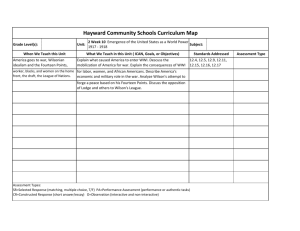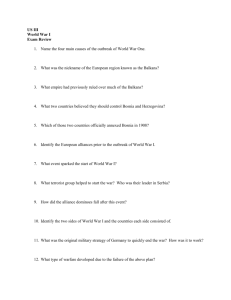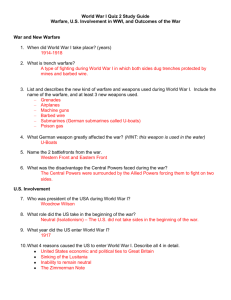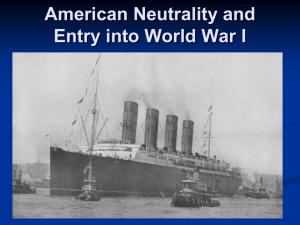Am Hist Ch 10 Notes
advertisement
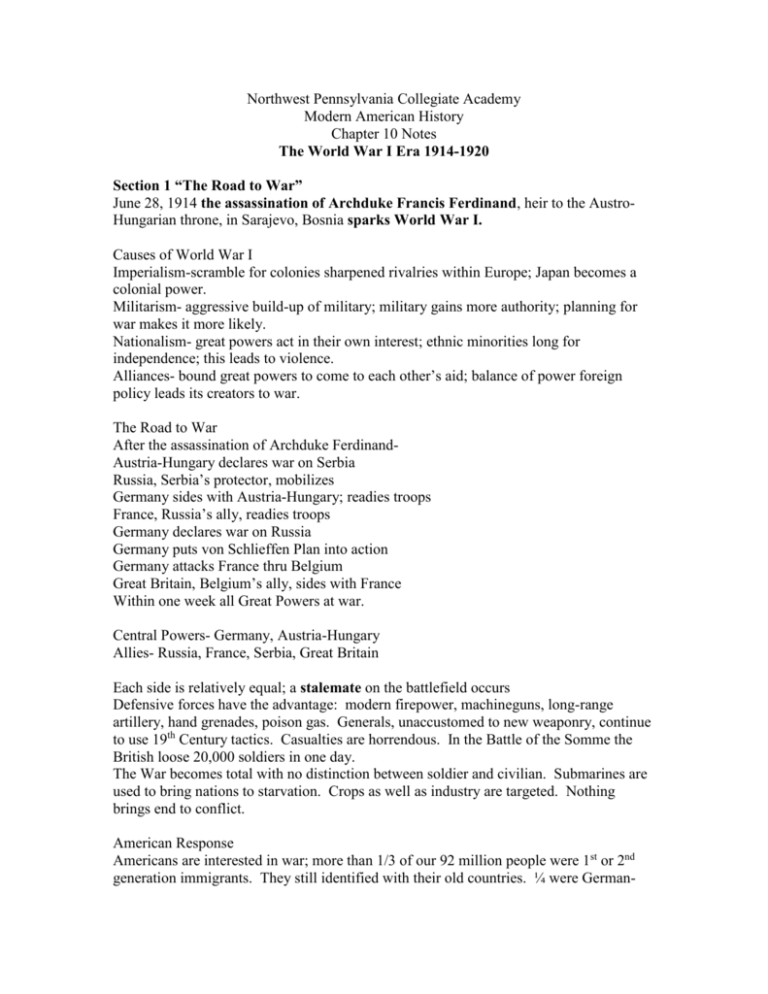
Northwest Pennsylvania Collegiate Academy Modern American History Chapter 10 Notes The World War I Era 1914-1920 Section 1 “The Road to War” June 28, 1914 the assassination of Archduke Francis Ferdinand, heir to the AustroHungarian throne, in Sarajevo, Bosnia sparks World War I. Causes of World War I Imperialism-scramble for colonies sharpened rivalries within Europe; Japan becomes a colonial power. Militarism- aggressive build-up of military; military gains more authority; planning for war makes it more likely. Nationalism- great powers act in their own interest; ethnic minorities long for independence; this leads to violence. Alliances- bound great powers to come to each other’s aid; balance of power foreign policy leads its creators to war. The Road to War After the assassination of Archduke FerdinandAustria-Hungary declares war on Serbia Russia, Serbia’s protector, mobilizes Germany sides with Austria-Hungary; readies troops France, Russia’s ally, readies troops Germany declares war on Russia Germany puts von Schlieffen Plan into action Germany attacks France thru Belgium Great Britain, Belgium’s ally, sides with France Within one week all Great Powers at war. Central Powers- Germany, Austria-Hungary Allies- Russia, France, Serbia, Great Britain Each side is relatively equal; a stalemate on the battlefield occurs Defensive forces have the advantage: modern firepower, machineguns, long-range artillery, hand grenades, poison gas. Generals, unaccustomed to new weaponry, continue to use 19th Century tactics. Casualties are horrendous. In the Battle of the Somme the British loose 20,000 soldiers in one day. The War becomes total with no distinction between soldier and civilian. Submarines are used to bring nations to starvation. Crops as well as industry are targeted. Nothing brings end to conflict. American Response Americans are interested in war; more than 1/3 of our 92 million people were 1st or 2nd generation immigrants. They still identified with their old countries. ¼ were German- American; 1/8 were Irish-American. Both felt hostility towards Great Britain. Most Americans opposed Great Powers. Kaiser Wilhelm was an autocrat, ruler of unlimited power. Americans saw Germans as militaristic and cold-blooded. American Neutrality U.S. trade influenced war position; German U-boats and British blockades were putting American investments at risk. To protect investments, Wilson declares American neutrality. He protested the actions of both sides and tried to be a peacemaker. Preparedness Movement American businessmen welcomed neutrality. Some with close ties to Great Britain urged preparedness for war; organized the National Security League to promote patriotic sentiment and education. Camps were set aside to train armed forces. Summer of 1916, Congress authorizes large increases in armed forces. Peace Movement The Peace Movement consisted of former Populists, Midwest progressives and social reformers. Women were very active. They founded American Union against Militarism. Congress increased taxes. Section 2 “The Unites States Declares War” From 1915-1917 friction grew between U.S. and Germany. Preparedness Movement gained support. Actions of Central Powers pushed Congress and President into War. German submarine warfare provoked calls for war. Submarine warfare was major factor in U.S. entering the War. Submarine warfare cost Germany dearly in terms of public opinion. Submarine was very effective weapon. U-boat changed the rules of naval warfare. It could go undetected; passenger and merchant ships were helpless. Uboats issued no warning to targets. British encouraged anti-German feelings; cut Atlantic cable connecting Germany and U.S. All news flowed thru Great Britain. News had a pro-Allies bias. In May 1915, German U-boat sinks the Lusitania in the Irish Sea. 1,200 passengers die, including 128 Americans. American press accuses Germany of barbarism. U.S. protested. Germans pledge not to sink ships if they no not resist and consent to search. With Sussex Pledge German government promised that U-boats would warn ships. Wilson is frustrated by broken promises, but could not threaten force with out entering the war. Wilson embraces the Preparedness Movement. Moving Toward War Presidential election of 1916- Wilson is narrowly elected. On February 1, 1917, Germany violated the Sussex Pledge by resuming unrestricted submarine warfare. Germany believes it can defeat Great Britain before U.S. enters war. Wilson realizes that he can no longer maintain American neutrality. U.S. breaks off diplomatic relations and Wilson requests from Congress the authority to arm merchant ships. Anti-war senators try to filibuster Wilson’s request. British reveal contents of Zimmermann Note. Germany makes secret offer to Mexico to join conflict on German side; not taken seriously but it was a great public relations victory for Great Britain. Revolution in Russia- see video clip. Russia makes peace. Germany-Austria can move troops from Eastern Front to Western Front. This could change the military balance, ending the stalemate. The War Resolution Between March 16 and 18, 1917, Germany sinks 3 U.S. ships. On March 20 Wilson’s cabinet votes unanimously for war. Wilson declares “the world must be made safe for democracy.” On April 6, 1917, the U.S. declares war. Role of public opinion in U.S. decision to enter WWI Public opinion plays a large role Business people with strong ties to Great Britain urged preparedness for war Other groups called for neutrality Public outrage grew with German submarine warfare and the Zimmermann Note By April, 1917 public opinion firmly behind declaration of war Section 3 “Americans on the European Front” General John J. (Black Jack) Pershing, Commanding General of American Expeditionary Force 3 million draftees- Selective Service Act National Guard Volunteers 300,000 African Americans- all served in segregated units and most were not allowed to fight. 369th Infantry Regiment (NY National Guard) Harlem Hell Fighters; fought with French Army; 4000 dead or wounded; unit was awarded French Croix de Guerre. 11,000 women served as nurses, drivers and clerks. 14,000 women served abroad as civilians working for the government. U.S employs the convoy system to bring men and material to Europe. A convoy consisted of cargo ships surrounded by a ring of destroyers, torpedo boats and other armed vessels. System was successful. Ship losses dropped by half. Turning the Tide of War Russian Revolution allows Germany-Austria to focus on Western Front. March to May 1918, Central Powers get within 50 miles of Paris. U.S. Marines and French Troops turn the tide of war at the Battle of Chateau-Thierry and save Paris. Allies Counterattack General Pershing more offensive minded. New weapon, the tank (see pg. 321) August 8, 1918, at the Battle of Amiens, Germans halted August 11, German generals advise surrender At Battle of St. Mihiel, 1st major U.S. controlled battle, Gen. Pershing and U.S. troops send Germans in full retreat. Airplane now used to bomb and strafe. Corporal Alvin York Ending the War November 11, 1918 armistice is agreed to. 50,000 Americans die in battle; many more die of disease. In all 8 million soldiers and sailors killed (estimate) Germany, Austria-Hungary, Russia and France all suffered more that 1 million dead. Almost 900,000 British troops died. Millions and millions of civilians died from starvation, disease and war-related injuries. In a campaign of genocide, Ottoman forces killed and deported millions of Armenians. Section 4 “On the Home Front” Financing the War- Liberty bonds were sold; redeem later for original value + interest; raised $20 billion. U.S. loaned $10 billion to allies; Boy and Girl Scouts sell bonds; 75,000 “4 Minute Men.” Managing the Economy Federal government regulated production of war goods; industry converts to produce war goods; business leaders go to Washington for token salary, “dollar a year” men and women. New Agencies- War Industries Board oversees war production; doles out raw materials, tells manufacturers what and how much to produce, fixes prices. War Trade Board licensed foreign trade, punished firms suspected of dealing with the enemy. National War Labor Board settled labor disputes War Labor Policies Board set standard wages, hours and working conditions Labor Unions won limited rights to organize and bargain collectively Regulating Food and Fuel Consumption Lever Food and Fuel Control Act gave the President the power to manage the production and distribution of foods and fuel. The Food Administration worked to increase agricultural output and reduce waste; imposed price controls and rationing. Fuel Administration imposed gasless days and daylight savings time. Was the War a Progressive Victory? Government regulates more but the regulation spills over to private areas of life; during war, influence of business leaders increases; government relaxes pursuit of antitrust suits; corporate profits tripled. Enforcing Loyalty News and information comes under federal control; censorship imposed on press and banned some publications from mails; Committee on Public Information rallies public support for war. Fear of Foreigners: fear of espionage and secret agents; calls for restrictions on immigration; National Security League call for “100% Americanization;” general hostility towards Germans (Huns). Repressing Civil Liberties Congress passes the Espionage Act and The Sedition Act. It is illegal to discuss anything “disloyal, profane, scurrilous, or abusive” about the American form of government, the Constitution, or the army and navy. 1500 cases pursued; 1000 convictions. Controlling political radicals Socialists opposed the war; they gained politically in some states; radical labor organization, the Industrial workers of the World (associated with communists) gained support; police hound IWW; vigilantes take action. Changing People’s Lives Social mobility for minorities and women Military styles and activities become more acceptable More jobs for Mexicans, African-Americans and women Congress proposes Prohibition Amendment African-Americans leave the south in a Great Migration to northern cities. Americans make sacrifices at home Conserving food and fuel Voluntarily cut down on use of wheat, butter, and meat Gasless days Daylight saving time Restrictions on civil liberties Buying Liberty Bonds Passage of Prohibition Amendment, in part to save grain Section 5 Global Peacemaker Wilson’s Vision of Peace- the Fourteen Points became Wilson’s program for peace: end alliances, remove trade barriers, reduce armaments, and self-determination for AustriaHungary’s ethnic groups. Paris Peace Conference- Wilson wanted to establish a permanent agency to guarantee international stability. Wilson is forced to compromise; allies divide German colonies; Germany given harsh penalties; $33 billion payment in reparations (a payment from one nation to another for economic injury suffered during war); these severe penalties were to directly lead to the conditions that lead to the rise of Adolf Hitler and World War II. League of Nations- worldwide organization aimed at ensuring security and peace. Article 10 pledged members of the League to regard an attack on one as an attack on all. The Versailles Treaty ended WWI and was signed on June 28, 1919. Seeking Approval at Home “Irreconcilables” opposed Treaty; did not want U.S. to join League of Nations. “Reservationists” wanted to impose reservations on U.S. participation in League. The Treaty was voted down in Senate, 39 for and 55 against. Difficult Post War Adjustments Jobs became scarce as discharged soldiers returned to civilian life. No plan for merging returning troops back into civilian life Many women had to voluntarily leave their jobs or be fired Post war gloom sets in; Americans no longer enthusiastic about war Realities of trench warfare, death, and destruction hit hard
